|
Routing
Last updated December 2024 Not only the airport, not only the fantastic steel and glass structures are representing the architecture of our time. There’s something else – the “abstract architecture” of flight routing, as an architects’ magazine has expressed it already half a century ago, the network of airline routes surrounding the globe, the invisible architecture of our time… And air traffic is using the shortest route, not along the degree of latitude. And air traffic is using the shortest route, not along the degree of latitude. 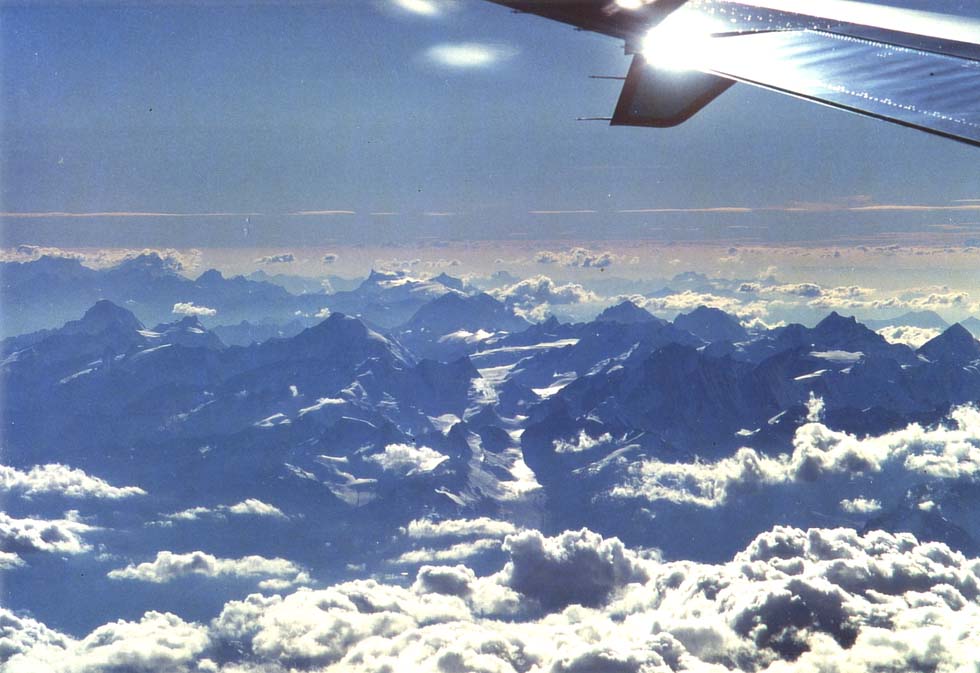 Crossing Switzerland, Berner Alpen, during an Athens – Zurich flight, 2001 (WS) Traditionally always the North Atlantic route was the most important intercontinental route. At the beginning of the jet age, America and Europe shared around two thirds of global traffic. The thinner routes to Asia-Pacific and other regions were a heritage from the prop age. Even Concorde supersonic services followed the old “colonial” routes London – Bahrain – Singapore and Paris – Dakar – Rio. The Soviet Union determined its international services stronger by political reasons: Egypt under Nasser, India under Nehru, Indonesia, Cuba under Castro, Chile under Allende became typical destinations, while Australia and New Zealand refused landing rights. North Korean planes appeared in the Soviets’ satellite capitals of Eastern Europe. Neutral countries like Tito’s Yugoslavia were eager to be connected with other neutral countries. And Mao’s China had its first European jet service to Enver Hoxha’s ultra-communist Albania, as a test. With the traffic growth of the Asia/ Pacific region, its routes to Europe and North America became more and more important. Nevertheless also in the 21st century the old tradition of subsidized “political” flights was continued. During the jet age, the route network across the globe was growing permanently. Reduced fuel consumption and bigger aircraft led to a steady extension of range. Long range permitted longer nonstop flights and did cut traveling time. With inauguration of its first Pacific Boeing 707 services in 1959, Pan American had changed its existing “round-the-world route” to jets. Due to restrictions, between New York and Los Angeles only the “the long way” was allowed to Pan American, and ten stops were necessary at London, Frankfurt, Istanbul, Beirut, Tehran or Karachi, Delhi, Bangkok, Hong Kong, Tokyo and Honolulu. Pan American avoided Israel, while TWA connected Tel Aviv with the USA. Also Qantas, BOAC, Air France/TAI, TWA and JAL offered round-the-world services. And Korean Air Lines undertook flights to Europe westward and eastward. However, they were uneconomic. In the 60s a Turkish colleague told that once, on a Pan American route sector from Istanbul to Germany, he was the only passenger on board. It’s logic that these proud routes had to give way to direct flights in connection with the hub-and-spoke system. 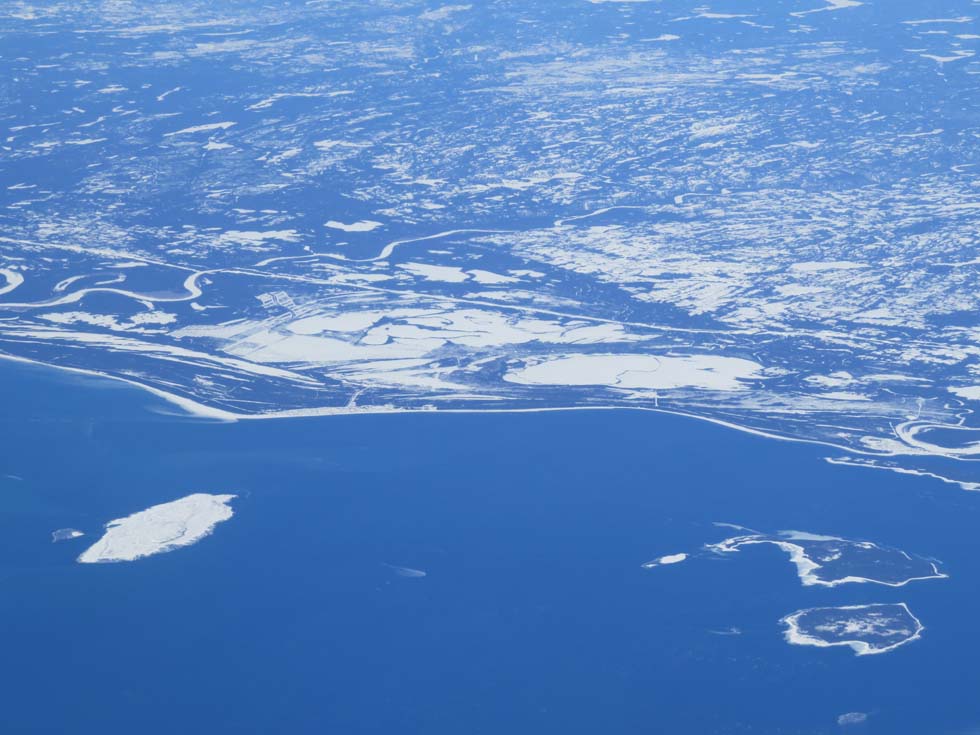 Having crossed the St.Lawrence Gulf on a flight Munich – Philadelphia, 2016 (WS) North Atlantic Services R.E.G. Davies listed the first North Atlantic services having been opened by Pan American Airways in July 1939 via Lisbon, by BOAC in May 1941, by American Export Airlines (which became American Overseas Airlines, acquired by Pan American in 1950), by Trans Canada Airlines’ wartime VIP service in 1943, by TWA, KLM, Air France and SAS in 1946, by Sabena in 1947, by Loftleidir in 1948, by L.A.I. in 1950 (merged with Alitalia in 1957), by El Al in 1951, in the 50s followed also by Iberia, Lufthansa, Qantas and Eireann (Aer Lingus). On occasion of the CAPSS security measure disputes in 2002, the most important European airlines on the North Atlantic were listed: British Airways with a 24% traffic share, Lufthansa with 19.5% and Air France with 13.5%. However, the North Atlantic route had not been the first jet route. After the failure of the Comet 1, it was started in 1958 by BOAC’s new Comet 4 and Pan American’s Boeing 707. Both had a refueling stop at Gander, Newfoundland. The 707-320 series, the first one being able of crossing the North Atlantic nonstop, came in 1959. The improved 707-320B turbofan variant of 1962 allowed nonstop flights from California to London over the “Great Circle” with slightly more than 11 hours traveling time. Introduction of the “Jumbo” B.747 and then the A380 were next steps. North Atlantic flights in west-east direction are tiring night flights, in east-west direction daylight flights, in accordance with the time zones. A different matter were the supersonic Concorde services, allowing daylight flights in both directions. As the supersonics did fly in the stratosphere and as there were only a few Concorde flights, the pilots could choose the shortest and most efficient route, not dependent on a fixed airtrack. With a large supersonic fleet however, that advantage would have disappeared, as the experienced Lufthansa pilot Rudolf Braunburg assumed it. 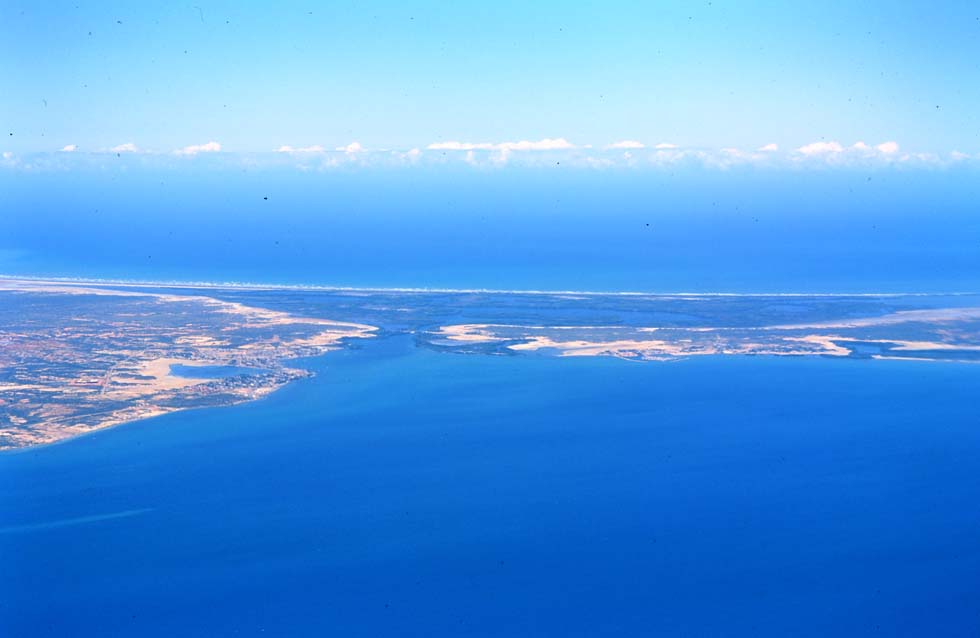 Reaching the coast of South America, Isla Margarita, Venezuela 2002 (WS) 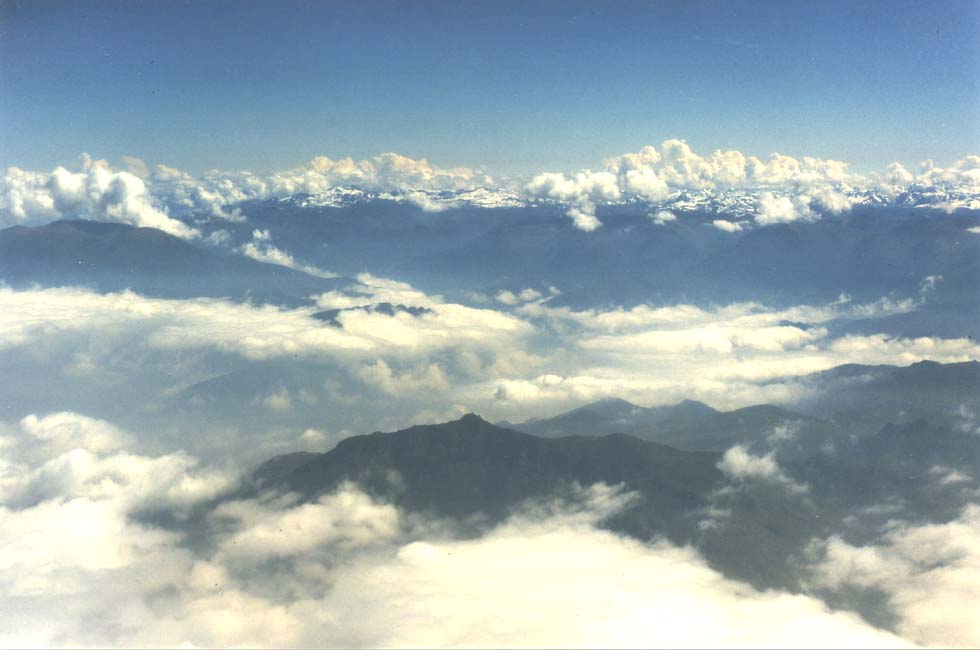 The Andes, during a Lima – Cuzco flight, 1996 (WS) South Atlantic Services The first South Atlantic jetliner route was inaugurated by Aerolineas Argentinas with the Comet 4 in 1959. It had four intermediate stops. The Boeing 707-320B enabled nonstop flights New York – Buenos Aires. Air France on its Rio flights still needed a stop either at Madrid or Dakar, and also the Concorde flights, started in 1976, needed a stop at Dakar. The 747-400 and the MD-11 allowed nonstop flights Europe – Buenos Aires within 13 to 14 hours, though most airlines preferred a stop in Brazil. Most Europe – South America flights in both directions are tiring night flights, but there are pleasant daylight flights to the Caribbean or with TAP to Brazil. 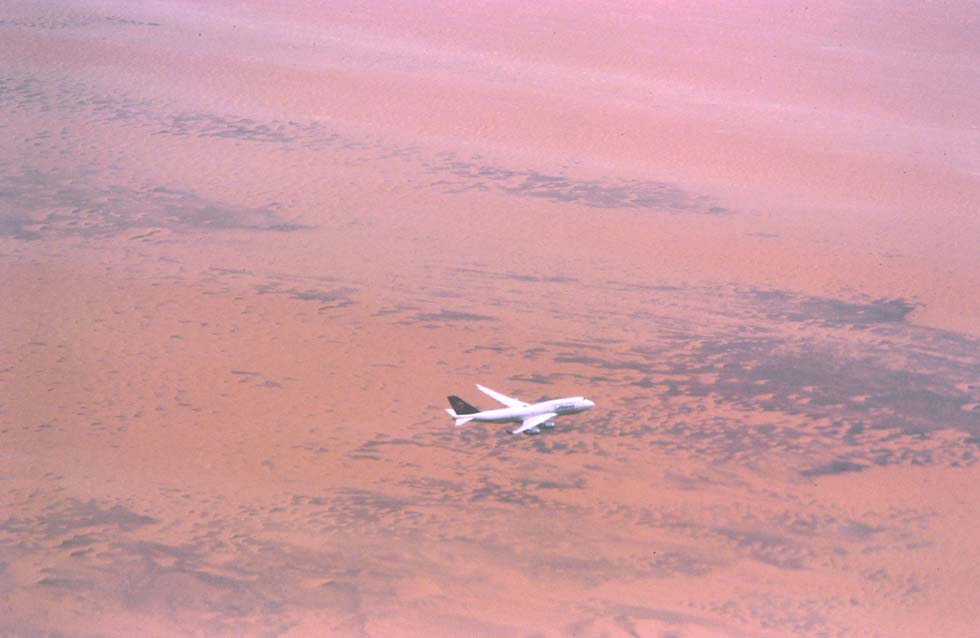 Lufthansa B.747-400 Frankfurt – Sao Paolo, crossing Mauritania, 2010 (WS)  Crossing the Libyan desert during an LTU flight to Cape Town, 2004 (WS) Africa Services When in 1952 the Comet 1 of BOAC has started its first regular jet service from London to Johannesburg, 5 intermediate stops were necessary. South African Airways with the Boeing 707 on its first New York flights in 1969 needed a refueling stop at Rio de Janeiro. Even the first 747-100 could not go nonstop from London to Johannesburg. During the years of the ‘apartheid’ horror, South African Airways was excluded from crossing many African countries. Most SAA flights had a stop at Cape Verde Isla do Sal, and other airlines stopped at Nairobi before the Boeing 747-400 had come. Later Europe – South Africa nonstop-flights took the straight line via Libya and Congo. On the routes to the south of Africa, tiring night flights as well as nice daylight flights are offered. 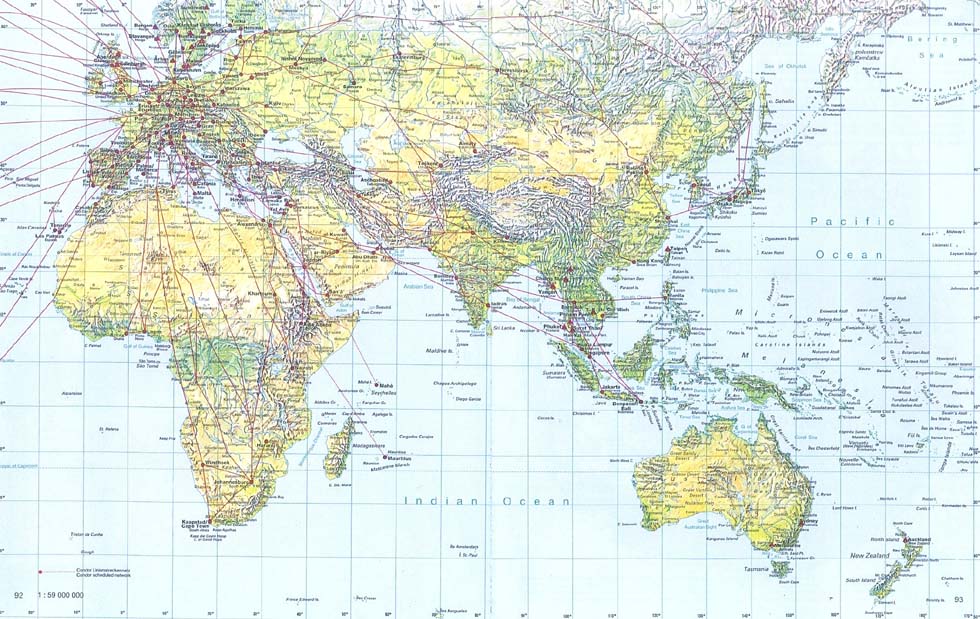 Lufthansa Africa and Asia routing, 1997 (courtesy Lufthansa, Bordbuch) Asia Services The second jetliner services had been inaugurated by BOAC’s “false start” in 1952 with the Comet 1 on the South East Asia route. During the first years of the 60s, Air France with the 707 needed at least five intermediate stops on its way from Paris to Tokyo. In 1958 Air India opened a route to Moscow via Tashkent with props. From 1964 PIA flew from Islamabad to London via Moscow. In 1967 SAS shortened the way to Bangkok by its ‘Trans Asian Express’ route with stops at Moscow and Tashkent. Due to the Vietnam war, overflight restrictions were an obstacle for flights e.g. between the Myanmar region and Hong Kong. In 1984 Cathay Pacific inaugurated the nonstop route from Hong Kong to London. Towards the end of the century, only poor airlines made refueling stops, such as Balkan on Sofia – Bangkok flights with stops at Dubai and Mahe. Avoiding the region between Syria, Israel and Iraq in favor of a Turkey - Iran route has become standard in the second half of the 20th century. Then Iraq was crossed regularly and a flight via Iraq and the Emirates appeared safer than via Iran. With the Afghanistan war in late 2001, of course this territory was avoided. In 2013, a Lufthansa flight e.g. from Germany to Delhi was watched crossing the Caspian Sea, Afghanistan and Pakistan, but not Iran. Later South Asia flights crossed Iran and Afghanistan regularly. In 2012 Emirates was watched taking a Turkey – Iraq route, but soon afterwards Emirates’ flights changed to the Iran route, avoiding Iraq. For the later background see the chapter Conflicts. Generally, jet aviation has made possible pleasant nonstop daylight flights in western direction from South East Asia to Europe. 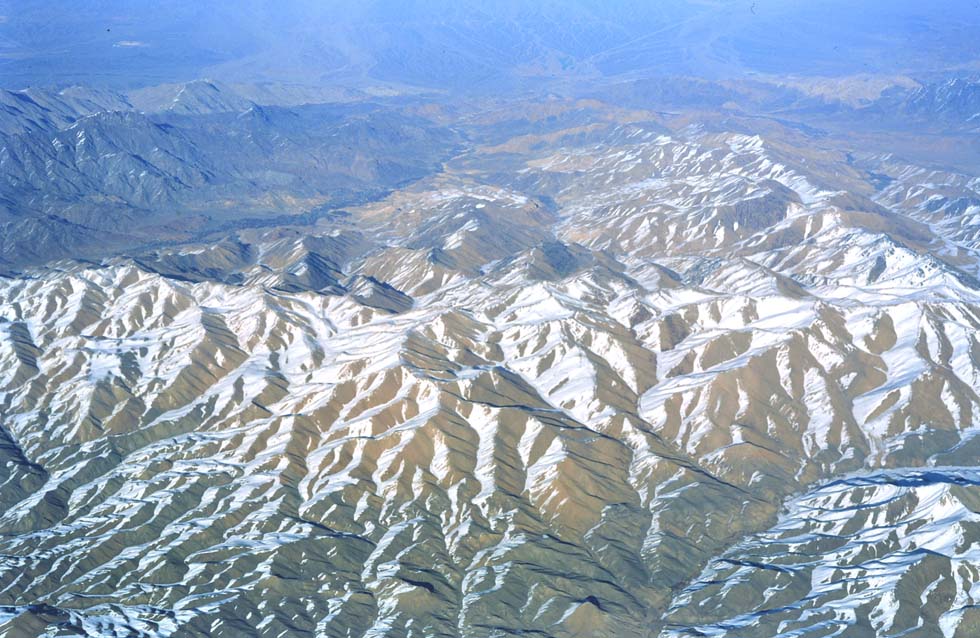 Zagros Mountains on a Singapore – Frankfurt flight, crossing Oman and Iran, 2001 (WS) Via Siberia In 1969 Aeroflot had cut traveling time Europe - Japan by introducing the IL-62 on a trans-Siberian route with a stop at Moscow, since 1967 flown already with Tu-114 turboprops in cooperation with JAL. Some Tu-114 appeared with a Japan Air Lines label, but CCCP registration (e.g. CCCP-76464). JAL introduced the DC-8 on this route in 1970. Air France became in 1973 the first Western carrier to fly to Japan via the Soviet Union. From 1986 nonstop flights between Europe and Japan via Siberia were allowed to Air France and JAL. Until 1988 Russia excluded wide-body aircraft and then and now it asks high fees for using its Siberian airspace. So the Anchorage route remained competitive. Due to difficulties with the Soviets, Lufthansa announced in 1990 the first true North Pole flights by a route Frankfurt – Tokyo via the Pole and the Bering Strait. Further negotiations opened up the North Siberian nonstop route and the problematic North Pole flights were not started. An old map showed Europe – Tokyo flights on a Siberian route via the Ural – Kotlas – Bor – Khabarovsk, while later a more northerly route was chosen via Estonia – Arkhangelsk – Vorkuta – Khabarovsk. As this route is passing the region between Finland and Russia, it appeared quite logic that Finnair offered its flights via the hub Helsinki. And in 2011 even Singapore Airlines praised the “north route” to Europe via Helsinki. Flights in west-east direction generally are night flights and in east-west direction there are pleasant daylight flights, too. Then the Airbus A380 had joined the fleet operating trans-Siberian and other Asian services.  Entering Siberia after crossing Mongolia during a Beijing – Frankfurt flight, 2017 (WS) In 2006 the dispute concerning the fees for flights over Siberia re-emerged when the EU tried to hinder Russia’s accession to the WTO, but Russia explained that the fees are based on bilateral agreements. In 2008 the media reported that LOT and Air Berlin abandoned Siberian overflights, but important airlines continued to use this short route. In 2010 Flight Intl (Nov02) reported: “Four European states are facing legal action from the European Commission over their bilateral air service agreements with Russia (…). The EC says the bilaterals with the four states – Austria, Finland, France and Germany – include specific provisions on paying Russian flag carrier Aeroflot for the right to overfly Siberian territory (…). The EC estimates that EU carriers paid $420 million in charges in 2008…” The Ukraine conflict caused Russia to ban Ukrainean flights over Russia. Beijing and Shanghai flights were watched crossing Belarus, Russia north of Moscow and Mongolia.  Crossing the Yakutsk-Norilsk region during a Tokyo – Munich flight, Feb 2005 (WS) Via Kazakhstan Towards the end of the century, air travel in the Asia/ Pacific region was expected to grow at double the rate experienced elsewhere. This region was defined by ICAO stretching from Afghanistan and Mongolia to New Zealand and Tahiti. In this region the longest nonstop flight had been inaugurated by Cathay Pacific with its direct Hong Kong – London service in 1983. It was rendered possible by the 747-200 with Rolls-Royce engines, covering the 7,225 miles in 13 hours. Singapore Airlines followed in 1989 with the even longer Singapore – London flights by the 747-400. Vietnam Airlines until 2005 still had an intermediate stop at Moscow. The Hong Kong route passed Tibet and the region of Almaty, Kazakhstan. In contrast to Russia with its expensive Siberian route, Kazakhstan is on international level. In 2011 a Hong Kong – Frankfurt Lufthansa flight could have been watched passing Tibet, south of Almaty, the northern shore of the Aral Sea and Ukraine – still before the downing of Malaysia Airline B.777 in 2014. Then this zone of Ukraine was avoided. Taiwanese flag carrier China Airlines shortened mainly its routes to the Middle East in 2005, when China for the first time opened its airspace to Taiwan.
Pacific and Polar Routing Northwest Airlines pioneered the grand circle route from the USA to Asia in 1947. SAS inaugurated its Great Circle Polar Route in 1954 to reduce distances between European and American points. From 1960, long before entering the Trans-Siberian route, Air France shortened traveling time between Paris and Tokyo by introducing its “Polar” route with one stop at Anchorage. In 1962 Pan American with the 707-320B reduced the distance between San Francisco and Tokyo by avoiding the detour via Honolulu. With the long-range (but uneconomic) Boeing 747SP, Pan Am inaugurated New York – Tokyo nonstop services via Alaska in 1976. Korean Airlines started Seoul – New York nonstop in 1985. In 1992 American and Russian authorities began studying the “true” North Pole route, the Russian-American Coordinating Group for Air Traffic was formed and in 1998 permission for 4 Polar Routes was given. Russia’s Far East, where in 1983 a Korean 747SP had been shut down, now may be crossed, against a financial compensation of course. There had been trial flights by United and Northwest with the 747-400 and by American Airlines with the 777-200ER, relying on Siberian diversion airfields. Cathay’s New York – Hong Kong nonstop service of 1998 was proclaimed being the first true North Pole route. In 2001 Continental inaugurated a nonstop B.777-200ER route Newark – Hong Kong. Singapore Airlines’ 16 hours flight Singapore – Los Angeles with the A340-500, avoiding the stop at Tokyo, started in 2004, followed by the even longer Singapore – Newark nonstop service in the same year. Only the return flight, due to the wind direction, was a North Pole flight, listed (via Wikipedia) with 15,345km as the longest nonstop route. Thai A340-500 nonstop flights Bangkok – New York started in 2005, announced as Pole flights. They returned via southern Greenland, London, Smolensk, Kabul. In 2007 the change to a one-stop service was reported. In 2012 Thai abandoned the Bangkok - Los Angeles non-stop A340-500 services and introduced a refueling stop at Seoul. Singapore Airlines decided to give back its five ultra-longhaul A340-500s when the end of the nonstop routes to Newark and to Los Angeles has come in late 2013. For 2018 a revival of the non-stop flights to the USA was announced by Singapore Airlines with the A350-900ULR. When Philippine Airlines ordered the A350XWB-900 for 2018, employing it on the Manila – New York nonstop flights was announced. In 2016 Air-India surprised by flying from Delhi to San Francisco eastbound via the Pacific within 14½ hours, despite the longer distance of 15,300km faster than the North Atlantic route westbound, caused by the west wind jetsteam. In the Southern hemisphere, nonstop flights Buenos Aires – Auckland had been started by Aerolineas Argentinas in 1981, reducing traveling time from 20 to 12 hours (according to R.E.G. Davies), described as Antarctic Trans-Polar flights. Later they were replaced by the even longer Buenos Aires – Sydney nonstop route. Qantas opened a Sydney – Santiago route. LAN offered Santiago – Auckland flights, its A340s then being replaced by the B.787. According to Wikipedia, “these can approach 55 degrees southerly latitude, though not enough to cross the polar ice cap.” True South Pole flights are to be avoided on ecological reasons. One-Stop or Non-Stop? The success of Emirates was based on the geographical position of its hub Dubai between the West, East, North and South. Dubai is the hub for Emirates’ “One-Stop” Sydney flights. For flights to Argentina and Brazil, Emirates had evaluated to acquire more B.777-200LR planes. The latter was announced for Dubai – Houston and Dubai – Rio de Janeiro flights. In 2009 Emirates introduced Dubai – San Francisco non-stop flights with the B.777-200LR, using the Arctic route. The 16-hour flight Dubai – San Francisco was reported (by MucLife, March 2009) reducing the fuel consumption by 8 tons kerosene. Emirates is the airline which had placed the most initial orders for the A380 and it introduced it in 2008 on New York – Dubai and then other routes. Etihad took daring risks in another way – see the chapter Air Traffic/ Mega Groups.
The global long-distance record has been a nonstop flight from London to Sydney in 1989 by a Qantas 747-400, covering the 17,850 km within 20 hours 9 minutes, but this was an experiment with special fuel and reduced load. Concorde on trials had been only 3 hours faster, on account of intermediate stops. The dream of future London – Sydney non-stop flights had re-emerged, either with a new A340 version or with the B.787-9, but Qantas abandoned that project and also the idea of Sydney – Dallas non-stop flights, realizing that they would be uneconomic. The Qantas flights Sydney – London with the A380 have one stop at Dubai for connection with Emirates. Another step has been the introduction of direct flights Johannesburg – Sydney by Qantas, avoiding the previous detours. New ambitions for ultra-long-haul routes arose with Qantas Airways’ “Project Sunrise”, pushed forward by its chief executive Alan Joyce, published by Financial Times in 2019 (Oct12). Singapore Airlines operated the longest commercial route between New York and Singapore, a distance of 15,334km, using the A350-900ULR. Qantas praised its Perth to London route, the flights being c.94% full. When tests with the B.787-9 were announced, Financial Times informed: “The flights will mark the first time that an airline has flown direct from New York to Sydney, a distance of more than 16,000km, and only the second time it has been between London and Sydney, a route of more than 17,000km that is expected to take up to 20 hours.” Airbus offered a long-range A350-1000 and Boeing proposed a version of its 777. Flight Intl (Oct01, 2019) informed that “Boeing puts long-range 777-8 on hold.” The first flight of the larger 777-9 took place, for delivery in 2021. Qantas decided in favor of the A350XWB-1000. About ultra-long-haul ambitions, the Financial Times report quoted Andrew Lobbenberg, an aviation analyst at HSBC: “This will probably remain a niche segment.” And Qantas’ “Project Sunrise” was filed away. Economic Considerations Traveling-time e.g. on the North Atlantic route has got longer on account of a slight speed reduction in favor of fuel economy. The regular flight time of a British Airways B.747 on a New York JFK – London LHR flight in 1980 had been 6 hours 40 minutes, in 1997 however 7 hours 55 minutes. It proved the nonsense of the stopped Sonic Cruiser project. Improved engine reliability encouraged the US Federal Aviation Agency (FAA) to introduce the extended range twin-engine operations (ETOPS) rules in 1985. It has enabled TWA to be the first airline operating the North Atlantic route with economic twins. Its Boeing 767-200ER had to take a route which enabled them to reach the nearest airport within 75 minutes. For the Pacific, the twins’ detour along the coast via Alaska would have been too long and so for a while it remained a domain of the quads. The basic 60min rule was expanded to 90, 120 and then to 180min OEI (one engine inoperative) diversion time. It seemed to endanger the Airbus A340 project, then under development. The FAA approved already 207min for the competing Boeing 777 twin. In 2003 the FAA examined to draw up new standards for long-range aircraft, taking all of them into a 240min ETOPS range. Some airports for emergency, such as Midway in the Pacific, no longer would be required. Commercial motivation for this 240min extension is that it covers most oceanic, north polar and wilderness routings. The European Joint Aviation Authorities (JAA) made radically different proposals. With the new Airbus A350 twin in competition to the Boeing twins, old safety arguments were “forgotten”. In 2010 the last A340 was delivered and subsequently many ones were replaced by twins. Weather and Health Weather conditions are influencing routing and cost. Of course pilots have to rely on the short-term weather forecasts, but there are also long-term predictions, e.g. by the Federal Climate Prediction Center of the USA, basing its forecast on El Nino or La Nina, the warming of the water in the eastern Pacific region around the equator, or Britain’s Meteorological Office, which bases forecasts on sea-surface temperatures in the Atlantic, or new methods considering the amount of snowfall in Siberia being the cause of jetstreams. The jetstreams are of fundamental importance for flight routing, fuel saving and timing. They are west winds blowing in the northern and in the southern hemisphere in altitudes which are the usual flight levels of jetliners, at speeds generally around 120km/h, but sometimes up to 400km/h. On that reason the regular flight time New York – London could be 7 hours 55 minutes, but London – New York 8 hours 35 minutes. Dependent on jetstreams, such a North Atlantic flight in east-west direction may cross Greenland and Labrador, while the west-east flight takes a more southerly route. Melting Arctic ice as a result of the threatening global warming caused a change in jetstreams, as scientists e.g. from the Potsdam Institute have found it out. South East Asia flights always are influenced by the Summer Monsoon or the Winter Monsoon. And on South Atlantic flights, the tempests of the Intertropical Front are challenging the pilot, an experience which already Saint-Exupery has made. Always some infections appeared, e.g. in 2014 the ebola virus in Africa. Much more frightening became the global threat of the coronavirus, which in late 2019 spread from Wuhan in China. Financial Times (Jan24, 2020) reported: “Since Wednesday, Wuhan has been under a near lock-down with air and rail links suspended…” Spiegel online informed that “British Airways interrupted any flight to China.” Also United and other airlines limited traffic. Air China continued international flights. Charter flights of the UK, USA and others had to evacuate citizens from Wuhan. When a German air force A310 carried evacuees to Frankfurt, a refueling stop at Moscow was interdicted by local authorities. Initially travelers were flying back from China and then tariffs soared for Chinese travelling home from Europe or the USA. Tables have turned, as The New York Times (March21, 2020) stated: “It is the West that now frightens Asia and the rest of the world.” Generally the passenger route network suffered drastic interruptions and cargo planes transported medical equipment. Route Fragmentation During years, costs had been reduced by point-to-point flights, omitting inefficient route segments. They were appreciated by the passengers, who no longer had to change plane and lose hours at overcrowded and understaffed hubs. A study, published by Railway Gazette Intl, has come to the result that passengers are classifying direct connections higher than comfort. It also seems that the number of daylight flights has grown, e.g. on routes Far East – Europe. So passengers could avoid the tiring night flight. With regard to Boeing’s 787 development, Aerospace America wrote in 2003 (March): “This makes an attractive fragmentation machine, giving airlines a great way of increasing frequency and bypassing unpopular hubs in favor of point-to-point services.” The renowned analyst Richard Aboulafia continued: “For example transatlantic departures of large widebodies, basically 747s, fell from 57,900 in 1990 to 54,400 in 2000.” On the other hand, important hubs must be served at convenient hours and that’s the reason for many parallel flights on heavily-trafficked long-haul routes. Parallel services could have been replaced by a smaller number of A380 flights with lower seat-mile costs, but the end of the A380 production disproved those predictions. With the ecological issue, more efficient routing has come on the agenda in order to reduce fuel consumption and pollution. “Optimizing air traffic control would further benefit the environment, because eliminating the need to fly around certain territories would cut emissions by 10 to 12%”, said Lufthansa Chairman Christoph Franz (Lufthansa-Magazin 04/2011). NextGen, Single European Sky and possible developments in Asia are to ameliorate routing (compare the chapter Safety + ATM). Timing and Network Some typical flying times (in hours) on non-stop routes in the first decade of the 21st century: Compared to traditional Greenwich Mean Time GMT, succeeded by the Coordinated Universal Time, the Standard Clock Time was defined e.g. for the Central European Time zone (stretching from Spain to Poland) +1 hour, for East European Time (e.g. Finland, Greece, Turkey, Ukraine) +2, for Moscow +3, in Arabia Dubai +3, in Africa Cape Town +2, in Asia Delhi +5:30, Bangkok +7, Shanghai +8, in the Pacific region Tokyo +10, Sydney +10, Auckland +12, in South America Rio -3, Santiago -4 and in North America New York -5, Los Angeles -8 hours. China has one time zone. Daylight Saving Time (DST), useful for saving energy, became standard mainly in Europe and in North America from March to October, the summer time, and in Australia from October to March, existent also in some South American countries (source: Thomas Cook European Timetable, Overseas Timetable, 2008/9). The International Data Line (IDL) passes through the middle of the Pacific Ocean with certain derivations, separating the Eastern Hemisphere (including New Zealand) from the Western Hemisphere (e.g. Hawaii). The importance of routes must be considered in connection with the region’s share in revenue passenger kilometers RPK – see the chapter Air Traffic. Since many years, forecasts expected the highest growth rates in RPK in the region between Mideast, Asia and the Pacific Rim, signaled last not least by the airports’ traffic: Between 2000 and 2010, Beijing leapt ahead from “nowhere” to rank 2 and Shanghai Pudong achieved the fastest growth - see the chapter Airports. How can airlines predict the traffic growth in relation to the regions concerned? R.E.G. Davies, later the most renowned air traffic historian, had established after WWII probably the first air transport market research department, being described supporting the sales of aircraft, e.g. the Comet. But what institution was the first to offer route network consulting? In Europe, the annual ‘Routes Europe’ meeting has become host of Route Exchange – Airline Requirement Briefings, a “feature which allows airlines to present their forthcoming plans and airport requirements…” (so reported by Airports of the World, July 2010). Network management consulting has become a new task and one of the pioneers, Philipp Goedeking, who founded in 2007 at Frankfurt airport the company Airconomy Aviation Intelligence, was quoted by Frankfurter Allgemeine (Feb23, 2009): “How many passengers are flying from Manchester to Istanbul? …The reservation systems and the airlines know only the number of passengers travelling on a certain route sector, but not how many altogether want to go from A to B.” What tourist agencies and airlines know since decades, is the fact that tourists of the wealthy northern countries of America and Europe are flocking to the south, towards the sun. Mega Regions With industrialization, people moved from rural areas to the cities. The “mega regions” are surpassing even the cities. “Our focus on cities is wrong. Growth and innovation come from new urban corridors”, wrote Richard Florida, author of the book ‘The Flight of the Creative Class’, in a Newsweek (July03, 2006) report, published under the headline “The new Megalopolis”. The term ‘megalopolis’ was “coined by the geographer Jean Gottman to identify the sprawling Boston-New York-Washington economic power corridor”, wrote R. Florida, emphasizing also China’s “exploding east-coast corridor from Beijing to Shanghai” and India’s “booming mega-region stretching from Bangalore to Hyderabad.” Among the 20 great mega-regions, 50% were still considered being situated in the United States, but fastest growing are the “Megas” in China and elsewhere. The mega-regions can also produce dangerous slums or ghettoes, like at Johannesburg or even in “Greater Paris”. Nevertheless the Newsweek report considered the mega-regions with optimism: “These regions are home to just 10% of total world population, 660 million people, but produce half of all economic productivity, two thirds of world-class scientific activity and three quarters of global innovations. The great urbanologist Jane Jacobs was the first to describe why megalopolises grow. When people cluster in one place, they all become more productive (…). Later, Nobel Prize-winning economist Robert Lucas dubbed these forces ‘human capital externalities’.” The successful “Megas” must be classified as regions, landscapes, not necessarily cities. And the dream of living in such a region, surrounded by a green landscape, has become an exemplary reality in the suburbs of Los Angeles. At the turn of the century, these new forces were concentrated mainly in the northern hemisphere. As the biggest Mega in economic terms was described the Boston-to-Washington corridor with 55 million citizens and “…$2.5 trillion in economic activity (…), bigger than France or the United Kingdom.” The Chicago-to-Pittsburgh corridor was described with $2.3 trillion in economic activity. ‘Euro-Lowlands’ is a center of activity, stretching over the Netherlands, Belgium, Luxembourg and parts of France and Germany, with roughly 50 million inhabitants bigger than ‘Greater London’ with 49 million. ‘Greater Tokyo’ with 55 million citizens is just a part of a Japanese super-mega region with around 100 million people. In superpower China, the Shanghai-to-Nanjing corridor, the Hong Kong-to-Shenzhen corridor and ‘Greater Beijing’ “account for most of Chinese economic output”, according to the above-mentioned report. Shanghai with surrounding regions became expected being a future 70-million “Mega”. The region around Guangzhou and the Pearl River was announced to become a mega city with 42 million people, though it is not a city, but a region. And the region around Beijing was reported (in 2016) comprising 130 million inhabitants. There are many other mega-regions spread around the globe, from Delhi to ‘Greater Seoul’ and to ‘Urban Italy’, that’s Italy’s industrialized North. They must not necessarily be situated around the country’s capital. Istanbul with 18 million inhabitants or Shanghai, Mumbai and Sao Paolo, with an estimated population around 20 million each being the biggest city of their country, are well-known examples. Mumbai (Bombay), together with Navi and Thane comprising even more than 20 million inhabitants, has a share of c.25% in industrial production and 70% in financial transactions of India. The mega corridor of Russia must still develop. The Newsweek report concluded: “It makes little sense to dwell on countries anymore, when the real engines are the New Megas.” Already in the first decade of the 21st century, half of Earth’s population was expected living in towns. Newsweek stated in 2006: “There are several megatrends that get lost in a top-ten list… One is the concentration of fast-growing cities in emerging economies: of the top-150 fastest-growing cities in this size class, the most by far, 55, are in China, followed by an intense boomlet of 12 in Indonesia, and 10 in India.” Mega cities with around 20 million inhabitants (suburbs included), such as Beijing, Shanghai, Mumbai, Mexico City or Sao Paolo, are well known. But who knew that also Lagos in Nigeria joined this club of cities with a population equaling that of Australia? And Dhaka in Bangladesh got 18 million inhabitants. The “Megas” developed in China and in the emerging economies. A study by the Mc Kinsey Global Institute (commented by Der Spiegel, Oct14, 2013) described Shanghai as the fastest advancing mega city, followed by Beijing, Tianjin and Sao Paolo. And the “Megas” marched ahead not only in economy. Praising cultural spaces in the 21st century as a part of the creative industry, the magazine Buehnentechnische Rundschau (2013) quoted Michael Schindhelm, a cultural consultant in the Middle East and Asia, stating that “the arts provide the key to making communities out of residential wastelands.” The development of mega cities must be a fundamental aspect for air transport’s future. It became analyzed by various scientific institutions, e.g. the annual conferences which had been organized by LSE Cities and Deutsche Bank’s Alfred Herrhausen, its results being published by the book ‘The Endless City’, commented by Peter Bourovilis in ‘2board’ (Athens, July 2012), stating: “Despite the negative impact on the environment, air travel between cities and metropolitan regions has increased at an exponential rate, fuelled by cheaper flights and market competition. Airports have become essential to the global positioning – or repositioning – of existing or emerging centres of finance, tourism and trade (…). The busy London – New York route tops the charge with 54 daily trips.” Despite all the setbacks and dangers, multi-national hi-tech activities did spread with multi-national staff, using English as the common language, still to be analyzed in context with the demographic development.  City nights, 2000 (courtesy NASA) NASA’s satellite photos of Earth during night hours are indicating the mega cities and regions showing their sparkling lights. Of course it’s not by accident that the contemporary German philosopher Peter Sloterdijk has included such a picture in his book “Sphaeren III”. He described “New Babylon” visions, he wrote the libretto for the opera “Babylon” and he commented: “Three quarters of mankind at present are excluded from the chances of affluence” (Wohlstandsklima). Nevertheless he stated (in the German magazine Focus, Feb 2013) that our epoch has turned to think about philanthropy and other traditional values. Air traffic as the only global means of transport in connection with a sophisticated planning of routes and, still more important, of fares may contribute to a solution of the problems of our epoch.
|






